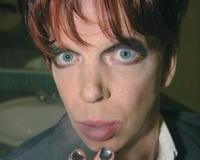 (Be) longing.
(Be) longing.Written and performed by Leslie Hill and Helen Paris.
The lights go up on Lesley playing ‘House of the Rising Sun’ on electric guitar. It is an excellent rendition of the well-known blues classic. After a few bars she stops playing, moves closer to the microphone and begins her monologue. But ‘House of the Rising Sun’ is still playing?…….
Lesleys’ first words are the frank admission that, despite taking lessons, she can’t play the Guitar. In what follows Lesley goes on to talk openly about her life’s various disappointments, both small and large, as the music continues to play. It is the soundtrack of this opening scene that both provides the melancholy backdrop to Lesley’s heartfelt story and acts as a poignant reminder of her sad air-guitar mime. But more importantly, this initial and very intimate scene sets the confessional tone of ‘(Be) longing’, in which tales of loss, love and longing are delivered with touching humour and pathos.
(Be) longing is spilt into two parts, with Lesley and Helen each performing solo for thirty minutes. Lesley is a one eighth cherokee cowgirl with a embroidered shirt and a mid-western drawl who longs for home, dreams of a fresh start and of being able to play the Blues. In comparison, Helen is a distinctly home grown disappointment; a UK woman who is tortured by her own thoughts, a longing for love and a routine addiction to coffee, cigarettes and wine. Both women want to fit in, to belong, and ‘long for’ the fantasies they act out on stage. But they ultimately fail to achieve their desires. However hard she tries Helen is unable to feel at home amongst the de-toxed yoga set or successfully dream of having sex with Jodie Foster, and Lesley bravely shows us just how pathetically bad she really is at the electric guitar (and its bad).
It is important for ‘(Be) longing’ that Lesley and Helen fail as it is clearly not the stories themselves but the longing embodied within them that is the main focus. It is a longing that is effectively pushed through Lesley and Helen’s comparatively different styles of acting and pulsates on stage, a longing that transmits out to the audience as painfully tangible and insistent. Throughout ‘(Be) longing’ desire is articulated into an animal; one to be wrestled with, one that tirelessly stalks these two women and-by implication-all of us. Conversely, it is the longing of ‘(Be) longing’ that overtakes Lesley and Helen to become the strongest element in the performance and the subsequent star of the show. Seen in this light, Helen and Lesley’s respective performances merely represent a vehicle for desire personified. And the desire they personify has two faces; the first (Lesley’s) is melancholy but ultimately productive, the flip side (Helen’s) is destructive.
In the end, Helen and Lesley want to belong, whether it is racially, socially or musically, but moreover they simply long. Theirs is perhaps a clear case of the grass is greener and the question might be: have they ever really ‘fit in’ and would they like it if they did? It’s doubtful. But it doesn’t matter. The real issue is the lack, the very longing to belong, that shapes life, love and everything else that lies in its path.
Rachel Lois Clapham











